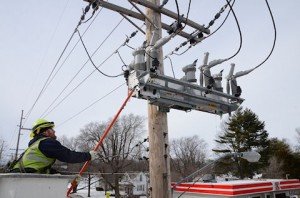First Micro Grid Powered Solely By Solar + Battery Storage
Green Mountain Power (GMP), Vermont’s largest power company, has broken ground on a new micro grid project called Stafford Hill Solar Farm on August 12 located on the city of Rutland’s former landfill. The micro grid will provide resiliency to the City’s high school, which is also an emergency shelter.
According to the U.S. Department of Energy, the 2.5MW Stafford Hill Solar Farm is the first project to establish a micro grid powered solely by solar and battery back-up, with no other fuel source.
The project helps GMP achieve its goal of making Rutland the solar capital of New England and Vermont to reach its renewable energy goals. It also incorporates 4MW of battery storage, both lithium ion and lead acid, to integrate the solar generation into the local grid, and to provide resilient power in case of an outage.
The project is partially funded by a federal-state-NGO partnership involving the State of Vermont; DOE’s Office of Electricity; and the Energy Storage Technology Advancement Partnership —a project managed by Clean Energy States Alliance and Sandia National Laboratories.
The $10 million project is anticipated to be completed in mid-December.
Illinois Utility to Roll out New Smart Grid Devices, Part of a $625M Upgrade
The utility Ameren has embarked on a $625 million smart grid upgrade across its Illinois territory, driven by the state’s new smart grid legislation that became law in 2013.
Some of the upgrades include the newly installed IntelliRuptor smart switching devices installed on telephone poles that can detect trouble on the line and automatically adjust power flow to minimize outages. Ameren Illinois installed 27 IntelliRupters in 2012, 12 in 2013 and has plans to install 93 more in 2014.

IntelliRuptor
The upgrades are working and outages were down by 20 percent in 2013, according to the company.
Other smart grid upgrades in Ameren’s territory include a wireless router, the Viper, which sends data from telephone poles to the company’s dispatch office. The Viper was launched by CalAmp in 2013.
Overall, the implementation of smart grid technologies can lead to an estimated cost savings of up to $2 trillion by 2030, according to the National Institute of Standards and Technology.
This move from Ameren speaks to the rise in utility adoption of emerging smart grid technologies and the growing activity in the segment. For example, San Francisco-based Smart Wire Grid, a provider of smart grid devices designed to control power flows on transmission lines, got $13.4 million in a Series B round of venture funding on March 12, 2014 from RiverVest Venture Partners and a second undisclosed investor. This was a partial close funding targeting a total of $18.39 million for the round, according to the SEC filing.
The DOE ARPA-E program provided Smart Wire Grid with initial funding to the tune of nearly $4 million in October 2012. At the Cleantech Innovation Summit, ARPA-E Director Cheryl Martin described Smart Wire Grid as a success story (see our coverage.)
Venture capital funding in the Smart Grid sector saw growth in Q2 2014, attracting $81 million in 13 deals versus $50 million in 10 deals in Q2 2013, according to Mercom Capital. However it was down from $101 million in 21 deals in Q1 2014.
Several Waste-to-Energy Project Developments
Baltimore, Maryland-based Omni-Alpha LLC, a renewable energy project developer, is investing $20 million to develop a waste-to-energy plant and deliver 2,250MWh of power annually to the Nevis Island Administration electricity grid of St Kitts, an island in the Caribbean Sea. Omni-Alpha will also build a solar farm to support the waste to energy plant, which is expected to become operational in 2015.
China Everbright International, a Hong Kong-based waste-to-energy project developer, has won the bid for the 1,500 ton per day Henan Xinzheng City Household waste-to-energy project. The Xinzheng Project will be constructed on a BOT (Build-Operate-Transfer) basis for a concession period of 30 years. The Project Phase I has a designed daily household waste processing capacity of 1,000 tons, equaling a total investment of about $85 million.
In addition to the Xinzheng waste to energy project, the company signed a concession agreement with the government of Pei County in Xuzhou of Jiangsu Province, for the investment, construction and operation of Pei County Household waste-to-energy project, as well as a concession agreement with the government of Beilun District in Ningbo of Zhejiang Province, for the expansion of Ningbo Beilun waste to energy project Phase II.
And UK-based Biogen, which designs, builds, owns and operates commercial-scale anaerobic digestion plants, announced a $12 million food waste-to-energy facility in Wales to recycle 22,000 tons of food waste annually. The plant is expected to produce 1MW of renewable energy and a bio-fertilizer that will be supplied to local farmers.
Biogen recently secured $37 million of funding from the Royal Bank of Scotland to support its continued expansion. The company received $42 million in 2011 from Kier Group, making the company a 50/50 joint venture between them and Bedfordia Group, their original investor.
And it was recently reported that Israel-based Bluesphere Corp. received a $15 million term sheet from private equity firm Energy Power Partners for the development of a 3.2MW waste-to-energy project in Johnston, Rhode Island.
Earlier in June, Bluesphere announced that it signed a memorandum of understanding to develop a 5.2MW waste-to-energy project in the Boston area. The Boston project will mark the third waste-to-energy facility in development for Bluesphere, which includes a project in Charlotte N.C. that is expected to be operational in 2015.